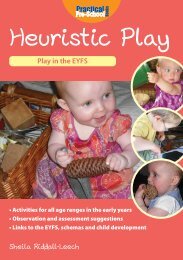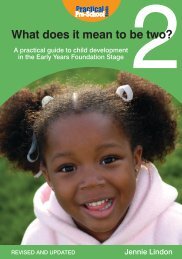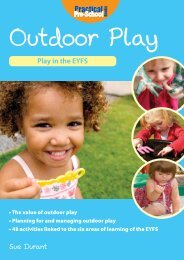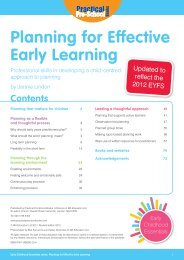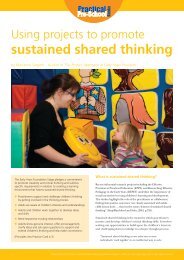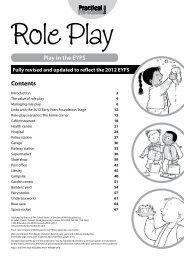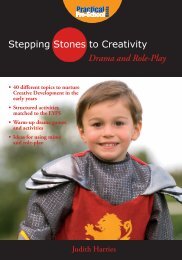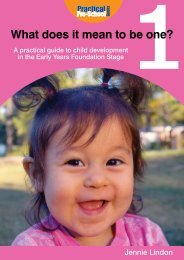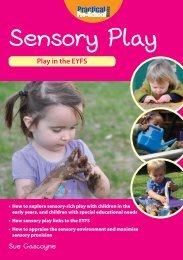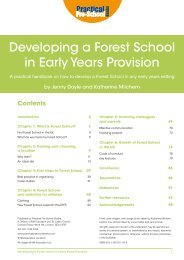The Project Approach - Practical Pre-School Books
The Project Approach - Practical Pre-School Books
The Project Approach - Practical Pre-School Books
Create successful ePaper yourself
Turn your PDF publications into a flip-book with our unique Google optimized e-Paper software.
<strong>Books</strong><br />
3-7<br />
years<br />
<strong>The</strong> <strong>Project</strong> <strong>Approach</strong><br />
in Early Years Provision<br />
A practical guide to promoting children’s creativity<br />
and critical thinking through project work<br />
by Marianne Sargent<br />
INCLUDES CD-ROM
<strong>Books</strong><br />
<strong>The</strong> <strong>Project</strong> <strong>Approach</strong><br />
in Early Years Provision<br />
A practical guide to promoting children’s creativity and critical thinking through project work<br />
by Marianne Sargent<br />
Contents<br />
3-7<br />
years<br />
About this book 2<br />
An introduction to<br />
the project approach 3<br />
What the project approach involves 3<br />
<strong>The</strong> project approach<br />
in early years provision 6<br />
Part One: Supporting early learning 9<br />
A child-centred approach<br />
to teaching and learning 9<br />
Developmentally appropriate practice 22<br />
Learning together 31<br />
Part Two: <strong>The</strong> project approach<br />
in action 41<br />
A cyclical process 41<br />
Identifying an interest 41<br />
Open-ended planning 45<br />
<strong>The</strong> role of the practitioner 51<br />
Concluding the project 65<br />
Part Three: Communicating<br />
the approach 69<br />
Explaining the rationale behind<br />
the approach 69<br />
Demonstrating how the<br />
approach works in practice 69<br />
Further information 72<br />
References 73<br />
Index 78<br />
Acknowledgements 80<br />
Published by <strong>Practical</strong> <strong>Pre</strong>-<strong>School</strong> <strong>Books</strong>, A Division of MA Education Ltd, St Jude’s Church, Dulwich Road, Herne Hill, London, SE24 0PB.<br />
Tel: 020 7738 5454<br />
www.practicalpreschoolbooks.com<br />
© MA Education Ltd 2011<br />
All photos © MA Education Ltd. Photos taken by Ben Suri and Marianne Sargent.<br />
Front cover photo: © iStockphoto.com/Sergey Galushko.<br />
Photo on page 12 of the Learning Story on the CD-Rom © iStockphoto.com/Danielle Davey<br />
All rights reserved. No part of this publication may be reproduced, stored in a retrieval system, or transmitted by any means, electronic,<br />
mechanical, photocopied or otherwise, without the prior permission of the publisher.<br />
ISBN 978-1-907241-17-8<br />
<strong>The</strong> <strong>Project</strong> <strong>Approach</strong> in Early Years Provision 1
An introduction to<br />
the project approach<br />
Current thinking supports practice that involves<br />
promoting independence in young children and giving<br />
them the tools to become proficient learners as they<br />
continue through their education (DCELLS, 2008a;<br />
DCSF, 2008; Featherstone and Featherstone, 2008;<br />
Glazzard et al, 2010). In recent years policy makers and<br />
researchers have placed emphasis on the importance<br />
of enabling children to take control of their learning. <strong>The</strong><br />
integration of Assessment for Learning methods into<br />
the Primary Strategies, as well as the focus upon critical<br />
thinking skills and the promotion of sustained shared<br />
thinking in the Early Years Foundation Stage (EYFS)<br />
guidance for England are other examples of this shift.<br />
<strong>The</strong> project approach is a child-centred teaching<br />
strategy that enables children to follow their<br />
interests and fascinations, while developing the<br />
independence, knowledge and thinking skills they<br />
will need to become life-long learners.<br />
What the project<br />
approach involves<br />
During a farm visit some nursery children<br />
were particularly interested in chicken eggs,<br />
which triggered a project all about eggs<br />
Early years practitioners will be familiar with the<br />
use of themes and topics when planning curriculum<br />
delivery. It is common practice to choose a new<br />
topic each half term and plan subject related<br />
activities around it. For example, practitioners<br />
might use a topic about growing as inspiration for<br />
planning activities across all six areas of learning.<br />
For example, mathematical activities might include<br />
measuring the heights of children or bean stalks;<br />
literacy skills might be practised in a role-play<br />
gardening centre as children take on different roles;<br />
physical activities may involve playing jumping<br />
bean games; children may develop knowledge and<br />
understanding by growing their own bean plants;<br />
they might create collages with paper petals; and<br />
they could share pictures of themselves as babies<br />
and find out about the needs of young children.<br />
Such activities serve their purpose and teach a<br />
range of knowledge and skills. However, although<br />
the overarching theme helps to create some<br />
commonality between areas of learning, teaching in<br />
this way can be disjointed and children often only<br />
scratch the surface in terms of learning any in-depth<br />
knowledge about the focus topic.<br />
<strong>The</strong> project approach entails taking an area of<br />
interest – which may stem from a topic – and using<br />
this as a basis for in-depth enquiry or research. Areas<br />
of learning are not simply linked by a topic or theme;<br />
they are integrated as a result of the investigative<br />
process. Knowledge and skills are not taught in<br />
isolation, but rather acquired and practised within<br />
a meaningful context that makes sense to children.<br />
All projects stem from the interests of the children<br />
<strong>The</strong> <strong>Project</strong> <strong>Approach</strong> in Early Years Provision 3
An introduction to the project approach<br />
might investigate individually, in groups or as a<br />
class and practitioners work alongside them to help<br />
develop and extend ideas. This means observing<br />
the children while they are working and perceptively<br />
helping them to share and sustain thinking with<br />
carefully considered open questioning.<br />
<strong>Project</strong>s give children practical opportunities<br />
to develop their knowledge and understanding<br />
of how the world works<br />
and are planned or developed in collaboration with<br />
children. This is in contrast to topics that might have<br />
initially been suggested by the children, but are<br />
ultimately “adult-controlled” (Nutbrown, 2006, p.33).<br />
Carrying out a project<br />
An idea for a project will usually come from<br />
practitioners’ observations of the children in their<br />
care. Such observations might highlight a particular<br />
interest that has the potential to be developed into a<br />
large-scale investigation or project.<br />
A project is started with an initial provocation, such<br />
as an event, question, picture or object that triggers<br />
conversation and debate. After the children have<br />
had some time to explore the provocation, they<br />
are gathered together to share their experiences<br />
and think about what they would like to find out<br />
or do next. <strong>The</strong> children’s questions, ideas and<br />
suggestions are recorded and practitioners meet<br />
together to discuss and use these as the basis<br />
for planning the project. Practitioners then set up<br />
various resources around the setting that will help<br />
facilitate the children’s explorations. <strong>The</strong> children<br />
Observation is a fundamentally important part of<br />
project work and practitioners plan to ensure that<br />
children’s investigations are thoroughly documented<br />
using written and photographic observations, as<br />
well as digital recordings. Any work the children<br />
produce is also kept or photographed. <strong>The</strong>se<br />
observations are used formatively to help plan the<br />
direction of the ongoing project. At the conclusion<br />
of the project, the documentation is used as a tool<br />
for reflection and shared with the children. This<br />
might be in the form of a learning story, where the<br />
children look back at what they did and hear their<br />
conversations and comments read back to them.<br />
<strong>The</strong> project approach to teaching and learning<br />
is not new. Froebel recognised that all areas of<br />
knowledge were interrelated and that children<br />
should be taught “to know the inner relations of<br />
things to one another” (1887, quoted in Bruce,<br />
2005, p.17). Isaacs’ substantial records of her<br />
observations at the Malting House <strong>School</strong> describe<br />
a range of investigations from children weighing<br />
each other using a see-saw, to digging up a dead<br />
rabbit to find out if “it’s gone up to the sky” (1930,<br />
p.41). Isaacs' observations led her to realise that<br />
if children are provided with opportunities to<br />
investigate their fascinations they will develop<br />
skills in applying knowledge to inform reasoning.<br />
In addition, the Plowden Report advocated an<br />
integrated curriculum because “rigid division of<br />
the curriculum into subjects tends to interrupt<br />
children’s trains of thought and interest and to<br />
hinder them from realising the common elements<br />
in problem solving” (CACE, 1967, p.197). <strong>The</strong><br />
report recommended project work because it<br />
“cuts across the boundaries of subjects” (CACE,<br />
1967, p.199). Current British early years curricula<br />
also support an integrated approach to curriculum<br />
delivery (CCEA, 2006; DCELLS, 2008a; <strong>The</strong> Scottish<br />
Government, 2008): “Although [the areas of learning<br />
and development] are presented as six areas, it is<br />
important to remember that for children everything<br />
links and nothing is compartmentalised.” (DCSF,<br />
2007, Principles into Practice Card 4.4).<br />
4<br />
<strong>The</strong> <strong>Project</strong> <strong>Approach</strong> in Early Years Provision
Part One:<br />
Supporting early learning<br />
It is useful to look at the project approach in<br />
relation to early years practice that is recognised as<br />
conducive to effective early learning. In this section<br />
three provocations are featured and discussed,<br />
illustrating how various pedagogical aspects of<br />
project work support and promote children’s learning.<br />
<strong>The</strong> discussion refers to the aims and principles of<br />
current British early years curricula and looks at how<br />
project work helps to meet requirements.<br />
A child-centred approach<br />
to teaching and learning<br />
<strong>The</strong> project approach is representative of a childcentred<br />
pedagogy that stems from a positive image<br />
of the young child as a competent learner who is<br />
capable of taking an active role in their education.<br />
<strong>The</strong> cocoon provocation featured in this section<br />
demonstrates the inclusive potential of projects and<br />
shows how they can enthuse children of all aptitudes<br />
and abilities, as well as motivate children to want to<br />
learn by building upon their interests. <strong>The</strong> discussion<br />
also considers the importance of giving children time,<br />
space and freedom to investigate phenomena in their<br />
own way and looks at the link between personal,<br />
social and emotional skills and cognitive development.<br />
A positive image of the child<br />
In Reggio Emilia, where projects are an integral part<br />
of early childhood education, the child is viewed as<br />
an “active constructor of knowledge” that is rich in<br />
potential (Hewett, 2001, p.96). Children are seen as<br />
apprentices for later life that have the ability to take<br />
an active role in their education:<br />
We have a highly optimistic vision of the child: a<br />
child who possesses many resources at birth, and<br />
with an extraordinary potential which has never<br />
<strong>Project</strong>s allow children to take control of their<br />
learning. Children are trusted to seek out<br />
information for themselves and empowered to<br />
find out more about what interests them<br />
ceased to amaze us; a child with the independent<br />
means to build up its own thought processes, ideas,<br />
questioning and attempts at answers… (Malaguzzi,<br />
2004, quoted in Bloomer and Cohen, 2008, p.16)<br />
Rinaldi (2001) describes this as a democratic<br />
approach that supports the rights of children to<br />
actively participate in their education. Current British<br />
early years curricula documentation attempts to<br />
reflect a similar philosophy, promoting respect for<br />
children as individuals with a focus upon personal<br />
development and wellbeing, as well as academic<br />
achievement. <strong>The</strong> EYFS depicts a positive view<br />
of the child as a “competent learner” who is<br />
“resilient, capable and confident and self-assured”<br />
(DCSF, 2007, Principles into Practice <strong>The</strong>mes and<br />
Commitments Card). <strong>The</strong> Scottish Curriculum for<br />
<strong>The</strong> <strong>Project</strong> <strong>Approach</strong> in Early Years Provision 9
Part One: Supporting early learning<br />
<strong>The</strong> Cocoon<br />
Rawdon Littlemoor Primary <strong>School</strong>, Leeds<br />
This provocation was set up in an Early Years<br />
Foundation Stage class of 45 reception children<br />
at a community primary school in Leeds. It was<br />
inspired by and planned to fit into a class topic<br />
on minibeasts. A fake cocoon constructed from a<br />
cereal box coated in paper-mâché and covered in<br />
green tissue paper was attached to the classroom<br />
ceiling with a toy minibeast inside.<br />
All practitioners were instructed to ignore the<br />
cocoon until the children spotted it – which<br />
happened immediately on the first morning. Quite<br />
a stir was caused as they crowded around in a<br />
throng of interest. <strong>The</strong> classroom assistants and<br />
teachers observed their reactions, recording any<br />
questions, ideas and comments using clipboards<br />
and digital cameras. It was decided that the<br />
adults should not try to offer any suggestions<br />
or answers, but simply ask open questions,<br />
allowing the children to theorise and deliberate<br />
for themselves.<br />
During the three weeks that followed, the cocoon<br />
was gradually opened to reveal the mystery<br />
minibeast. Its emergence caused a great deal of<br />
excitement, so much so, that on some occasions it<br />
was necessary to gather the children on the carpet<br />
and divide into talk partners. This encouraged<br />
them to engage in sustained discussion with one<br />
another and allowed them time to express their<br />
own views and consider the opinions of others.<br />
Tom hatching from the cocoon<br />
After the cocoon fully hatched the control of the<br />
project shifted over entirely to the children and the<br />
role of the adults became to help facilitate their<br />
ideas. <strong>The</strong> children named the creature Tom. <strong>The</strong>y<br />
drew pictures of him and made food items and<br />
water bottles for him. <strong>The</strong>y found out that Tom<br />
was related to Flik from the Pixar film A Bug’s Life,<br />
and this led to an exchange of letters between the<br />
children and Flik over in America. Some children<br />
then began to bring in storybooks about Flik to<br />
share with the class.<br />
Excellence states its purpose as “to enable each<br />
child or young person to be a successful learner,<br />
a confident individual, a responsible citizen and an<br />
effective contributor” (LTS, 2010). <strong>The</strong> Foundation<br />
Phase Framework for Children’s Learning for 3<br />
to 7-year-olds in Wales states an aim to ensure<br />
that children “are listened to” and “treated with<br />
respect” and maintains “children’s own work<br />
should be respected, valued and encouraged for its<br />
originality and honesty” (DCELLS, 2008a, pp.3 and<br />
5). Furthermore, the Northern Ireland Curriculum<br />
states its aim as to “empower young people to<br />
develop their potential” and views development as<br />
an individual as equally important to development<br />
as a citizen (CCEA, 2007, p.4).<br />
<strong>The</strong>re will always be curriculum documentation and<br />
policy guidance in place for early years educators<br />
to adhere to. <strong>The</strong>re will also be an ever-increasing<br />
body of academic research that aims to help improve<br />
understanding of how young children learn and<br />
enhance foundation stage practice. Early years<br />
practitioners have the extremely difficult task of<br />
trying to deliver an age-appropriate curriculum, while<br />
10<br />
<strong>The</strong> <strong>Project</strong> <strong>Approach</strong> in Early Years Provision
Part Two: <strong>The</strong> project<br />
approach in action<br />
So far this book has provided some examples of<br />
simple open-ended provocations that were set up<br />
and allowed to evolve organically without any set<br />
structure or format. This second part of the book<br />
takes a practical look at carrying out a full-scale<br />
planned project. It offers:<br />
• Suggestions for finding starting points<br />
• Details of the planning process with explanatory<br />
examples of how to create planning documents<br />
• A consideration of the central importance of<br />
collecting, interpreting and documenting observations<br />
• Explanations of how this documentation is used to<br />
inform the development of a project<br />
• Links throughout to adaptable and printable<br />
planning and observation documents, which are<br />
contained on a separate CD-Rom attached to the<br />
inside front cover of the book<br />
A cyclical process<br />
<strong>Project</strong> work is a cyclical process involving<br />
open-ended planning that is informed by<br />
ongoing observation, reflection, discussion and<br />
interpretation (see Figure 2). Throughout the life<br />
of a project, practitioners observe the children’s<br />
activities, investigations and conversation. <strong>The</strong>y<br />
then take time to reflect upon their observations<br />
before sharing and discussing them with each other,<br />
as well as the children. Practitioners meet regularly<br />
throughout the life of a project to review this<br />
documentation and develop planning in response.<br />
This ongoing observation and interpretation is<br />
referred to by Rinaldi as a “spiral of documentation”<br />
(2000, quoted in Thornton and Brunton, 2009, p.110)<br />
and is used to inform the continuing development<br />
of the project.<br />
Figure 2: <strong>Project</strong> work is a cyclical process<br />
<strong>The</strong> following explanation about planning, carrying<br />
out and documenting project work is very much<br />
influenced by the underlying child-centred principles<br />
represented by the Reggio approach in combination<br />
with the more structured framework provided by Katz<br />
and Chard (1989; 2000).<br />
Identifying an interest<br />
A project is most likely to grab the attention of the<br />
children if it stems from their own particular interests<br />
and fascinations. <strong>The</strong>re are various ways of picking out<br />
a starting point for a project, which could be triggered<br />
by any number of things. An idea may come as a<br />
direct result of a child’s actions or questions. On the<br />
other hand, practitioners might build upon observed<br />
interests and use them as inspiration for setting up a<br />
provocation. For example:<br />
A topic: <strong>The</strong> children might be interested in a<br />
particular aspect of a current topic. For example,<br />
<strong>The</strong> <strong>Project</strong> <strong>Approach</strong> in Early Years Provision 41
Part Two: <strong>The</strong> project approach in action<br />
those learning about outer space might be curious<br />
about the kind of food astronauts eat, which may<br />
lead to an investigation into dried foods.<br />
An object: A child may bring something into the<br />
setting. This might be a religious artifact, leading<br />
to a project about a particular religious festival.<br />
Or it might be a holiday souvenir from another<br />
country, leading to an exploration of the customs<br />
of the people from another culture. Otherwise, the<br />
practitioner might recognise that the children have<br />
a particular interest in something and introduce<br />
or plant an object somewhere in the setting that<br />
triggers an investigation. <strong>The</strong> cocoon provocation on<br />
page 10 is an example of this.<br />
An event: This could include birthdays, festivals,<br />
holidays, parties, births, deaths, visits and visitors,<br />
or doctor, dentist and optician appointments. <strong>The</strong><br />
excitement, anticipation, concern or anxiety surrounding<br />
any of these is reason to delve into an exploration that<br />
leads to gaining deeper knowledge and understanding.<br />
A question: A child might ask a question that offers<br />
a perfect opportunity for a large-scale in depth<br />
investigation. Otherwise, the children might have<br />
All about eggs<br />
Horton Grange Primary <strong>School</strong>, Bradford<br />
This project was carried out in an 80-place nursery<br />
in an inner city community primary school in<br />
Bradford, where the majority of children speak<br />
English as an additional language. <strong>The</strong> project<br />
emerged from the nursery’s topic about farming<br />
and was planned in response to a provoking farm<br />
visit. While at the farm the children experienced<br />
holding a young chick on their arm and were<br />
amazed when the farmer brought out a full-grown<br />
chicken and demonstrated how chickens lay eggs.<br />
<strong>The</strong> following day the children were brought<br />
together in their home groups to talk about the<br />
visit. <strong>The</strong> children remembered feeding the<br />
animals, climbing on a tractor, seeing mother<br />
animals with their babies, and then washing<br />
their hands to prevent the spread of germs.<br />
However, the predominant and reoccurring theme<br />
was chickens and eggs and the children were<br />
particularly excited when recalling the chicken<br />
laying the egg, describing it as a magic trick. It<br />
seemed that this interest in eggs was also due<br />
in part to the upcoming Easter festival and the<br />
school Easter Egg Competition, which had been<br />
launched the previous week.<br />
A project called ‘all about eggs’ was launched<br />
and during the weeks that followed the children:<br />
investigated what happens when eggs are broken;<br />
learned about different methods of cooking eggs;<br />
A provoking farm visit highlighted<br />
an interest in chickens and eggs<br />
examined and compared the properties of raw and<br />
cooked egg; looked closely at a variety of eggs<br />
produced by different farm birds; and learned a<br />
little about the journey of the egg from farm to<br />
shop. In response to the children’s high level of<br />
interest, the practitioners also hired an incubator<br />
from a local farm and during the following term the<br />
children were treated to the real-life spectacle of<br />
chicken eggs hatching.<br />
42<br />
<strong>The</strong> <strong>Project</strong> <strong>Approach</strong> in Early Years Provision
Part Three: Communicating<br />
the project approach<br />
This final section is intended as a guide for leaders<br />
and managers of early years settings, as well as<br />
trainers. It aims to provide some guidance and<br />
resources to help communicate to others how to<br />
use the project approach, as well as the theory<br />
behind it. Practitioners or students might also like<br />
to use the resources provided here to reflect upon<br />
what they have read in the book and consolidate<br />
what they have learned. This section should be used<br />
in conjunction with the resources on the CD-Rom<br />
attached to the front of the book.<br />
Explaining the rationale<br />
behind the approach<br />
When communicating the project approach to<br />
others it is useful to explain the rationale behind<br />
it. Practitioners will be more comfortable with an<br />
approach if they understand the theory and research<br />
that underpins it. <strong>The</strong> first part of this book looks<br />
at how the approach fosters particular aspects of<br />
educational practice that support effective early<br />
learning. <strong>The</strong> main points have been summarised and<br />
put together to create a presentation, <strong>The</strong> Rationale<br />
Behind the <strong>Project</strong> <strong>Approach</strong>, which can be found<br />
on the CD-Rom. This presentation sets the scene<br />
and provides a context for a further training session<br />
about the practical aspects of planning and carrying<br />
out provocations and projects. <strong>The</strong> slides feature<br />
diagrams that aim to simplify the theory and make it<br />
more accessible. <strong>The</strong> presentation is also concluded<br />
with a summary of key points. It would be useful to<br />
print this presentation out for trainees to annotate<br />
during the training.<br />
Demonstrating how the<br />
approach works in practice<br />
A second presentation entitled Planning and<br />
Carrying out <strong>Project</strong>s is also provided on the<br />
CD-Rom. This is intended as a more interactive<br />
resource that encourages trainees to get involved<br />
and experience the approach first-hand while<br />
providing a step-by-step explanation of how<br />
provocations and projects are carried out. <strong>The</strong><br />
following is a suggestion for how the training<br />
session might be organised.<br />
Planning and Carrying out<br />
<strong>Project</strong>s presentation<br />
Resources needed<br />
• Some unusual objects<br />
• Clipboards, paper and pens<br />
• Large sheets of paper and marker pens<br />
• Digital cameras<br />
• Easy access to a number of computers and a printer<br />
• Scissors and glue<br />
• Training handouts from the CD-Rom<br />
<strong>The</strong> Rationale Behind the<br />
<strong>Project</strong> <strong>Approach</strong> presentation<br />
Training handouts and learning story<br />
from the all about eggs project<br />
<strong>The</strong> <strong>Project</strong> <strong>Approach</strong> in Early Years Provision 69




